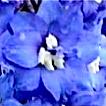
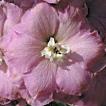
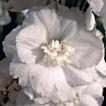
from Seedsmen

from Seed

| Return to Home Page |
| Delphiniums
from Seed A set of pages illustrating our activities in hybridising delphiniums and the selection of seedlings with improved characteristics |
| Breeding Delphiniums |  |
|
| Breeding Delphiniums |  |
|
| Breeding Delphiniums |  |
|
| Delphinium Seeds available in 2011 from Seedsmen |
 |
|
| Raising Delphiniums from Seed |
 |
General Introduction
One of the greatest joys in gardening is to
watch the first flowers develop on a plant you have raised from
seed. This is true whatever the source of the seed but it is
especially exciting when that seed resulted from your own efforts
at hand-pollinating the flowers of a favourite delphinium. The
opening buds hold the answers to all those questions you have
asked for the past twelve months, such as: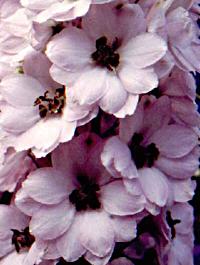
Most of the delphinium seedlings we raise are never seen outside our own garden because few ever fully meet the standards we set ourselves. Even so, many seedlings have beautiful flowers with a wider range of colours and form than is available in delphiniums from a Garden Center. Here we share some of the good flowers that we have raised and also some of the failures.
Growing from Seed
An advantage of delphiniums is that the generation time is short. It is easily possible for the amateur hybridist to make a cross in June/July, the normal flowering time in England, and then see the flowers of the seedlings during the summer of the following year. The period can be shortened by sowing the seed immediately it is ripe in July or August. We do not do this because we lose too many small seedlings due to botrytis (grey mould) in autumn. There is also a tendency for seedlings that go dormant during the winter to 'bolt' to flower, which results in unrepresentative miniature blooms. We therefore store the ripe seed in a refrigerator until required and sow indoors in early spring.
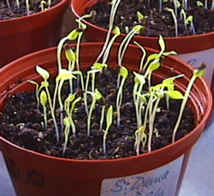 February sown seedlings, like those seen here at 5/03/01,
then grow without a check and normally produce full-size blooms
from early August onwards. These tiny seedlings each produced a
bloom about 1m (3ft) long in August or September! Unfortunately 25% of the seedlings grown
in 2002 failed to produce a flower stem at all despite developing
into very large plants. This frustrating situation is partly due
to weather conditions but is primarily a characteristic feature
of the particular crosses grown. It is a fairly common problem
with seed from delphiniums having dusky pink flowers. In 2004,
for example, 75% of the seedlings from a cross using 'Summerfield
Diana' had only a basal rosette of very large leaves at the end
of the season and did not flower. They all had to be kept another
year but then several of the blooms were exhibited at the
Delphinium Society Show, one being judged best bloom in the Show!
February sown seedlings, like those seen here at 5/03/01,
then grow without a check and normally produce full-size blooms
from early August onwards. These tiny seedlings each produced a
bloom about 1m (3ft) long in August or September! Unfortunately 25% of the seedlings grown
in 2002 failed to produce a flower stem at all despite developing
into very large plants. This frustrating situation is partly due
to weather conditions but is primarily a characteristic feature
of the particular crosses grown. It is a fairly common problem
with seed from delphiniums having dusky pink flowers. In 2004,
for example, 75% of the seedlings from a cross using 'Summerfield
Diana' had only a basal rosette of very large leaves at the end
of the season and did not flower. They all had to be kept another
year but then several of the blooms were exhibited at the
Delphinium Society Show, one being judged best bloom in the Show!
The growing procedure used is described in the Delphinium Society's illustrated cultivation leaflet "Delphiniums from Seed to Flower in Six Months". This costs £0.75 / $(US) 2.0 (price includes postage) and can be obtained from the Membership Secretary of The Delphinium Society.
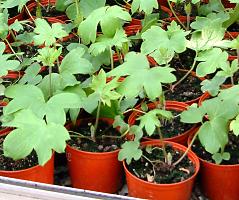 Typically, our seedlings are pricked out
into individual pots during the first two weeks of April, and
seedlings are ready for planting out in late May, as seen in the
picture. These seedlings were planted in the open ground between
May 26th and June 14th 2004. Many of the plants had expanding
spikes in early August with a few florets showing colour.
Typically, our seedlings are pricked out
into individual pots during the first two weeks of April, and
seedlings are ready for planting out in late May, as seen in the
picture. These seedlings were planted in the open ground between
May 26th and June 14th 2004. Many of the plants had expanding
spikes in early August with a few florets showing colour.
Ground preparation is best done during winter and spring when possible. With a limited amount of space in our garden, the beds where the seedlings are to be planted start the year filled with the seedlings grown last summer. The first task is therefore to replant selected seedlings as soon as they start into growth but only when the weather and soil conditions are suitable. We then clear out unwanted plants and incorporate compost or manure into the planting sites. In 2004, a light dressing of Blood, Fish & Bone fertiliser was incorporated in the soil when preparing the ground for the new seedlings. The plants selected in 2003 were moved to new flowering sites in late-February 2004 but long dry spells and dull weather meant they did not grow well until after watering and mulching in early June.
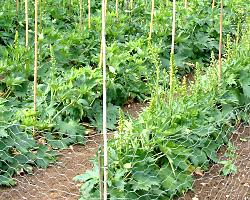 Seedlings are planted in rows 45cm/1.5ft
apart, with a spacing between plants of about 30cm/1ft, as each
plant produces just one flower stem (sometimes 2.5m/8ft tall).
Blooms are supported by running twine between canes inserted
between plants in a row. A plot approximately 10m/30ft x 5m/15ft
provides space for about 200 plants and we aim to grow about 400
seedlings a year.
Seedlings are planted in rows 45cm/1.5ft
apart, with a spacing between plants of about 30cm/1ft, as each
plant produces just one flower stem (sometimes 2.5m/8ft tall).
Blooms are supported by running twine between canes inserted
between plants in a row. A plot approximately 10m/30ft x 5m/15ft
provides space for about 200 plants and we aim to grow about 400
seedlings a year.
We normally expect to spray plants at least twice with a systemic fungicide to control mildew and sometimes spray with a systemic insecticide to control caterpillar infestations that can seriously damage developing flower spikes during August. In 2003, some seedlings were seriously damaged by voles (small rodents) eating young flower stems and leaf stalks. This happened again in August 2004 when voles were seen running among the plants during the day. We have been told of similar activities by voles damaging delphiniums in the USA!
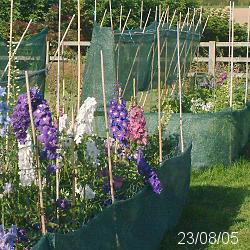 Moving house and garden in 2005
disrupted these long-established routines, as there was no garden
ready to take seedlings. Instead, seedlings were repotted into 2litre
pots and grown in them throughout the summer. About 200 plants
were grown, with the pots standing on Mypex sheet (woven ground-cover
fabric) laid over turf in our new garden, with the grass first
being shaved off as short as the mower allowed. During July, the
pots could be watered only twice a week. It was therefore
essential to shade the pot standing ground and to surround the
area with wire netting to prevent rabbits destroying the plants.
Despite the difficulties, the plants survived and almost all
flowered providing some indication of flower quality, even though
blooms were very small compared to seedlings grown in the open
ground. Seedlings were again grown and flowered successfully in 2
or 4litre pots in 2006 due to problems in preparing new areas for
planting. The worst aspect of the method is the time taken in
watering the pots to keep the plants alive in such a hot summer.
Moving house and garden in 2005
disrupted these long-established routines, as there was no garden
ready to take seedlings. Instead, seedlings were repotted into 2litre
pots and grown in them throughout the summer. About 200 plants
were grown, with the pots standing on Mypex sheet (woven ground-cover
fabric) laid over turf in our new garden, with the grass first
being shaved off as short as the mower allowed. During July, the
pots could be watered only twice a week. It was therefore
essential to shade the pot standing ground and to surround the
area with wire netting to prevent rabbits destroying the plants.
Despite the difficulties, the plants survived and almost all
flowered providing some indication of flower quality, even though
blooms were very small compared to seedlings grown in the open
ground. Seedlings were again grown and flowered successfully in 2
or 4litre pots in 2006 due to problems in preparing new areas for
planting. The worst aspect of the method is the time taken in
watering the pots to keep the plants alive in such a hot summer.
In 2007 we returned to growing
most of our seedlings in the open ground. We have grown both our
own hand-pollinated crosses and some of the F1 hybrid strains
that featured in the 2007/2008 RHS Trial of Delphiniums from Seed.
In 2009 we grew some of both the Centurion Seed Lines and New
Millenium Hybrids for comparison with our own hand-pollinated
crosses. In recent years we have also raised seedlings from open-pollinated
seed saved from parents in a specific colour group. Our results
indicate that in general such seed does not provide a
particularly high chance of obtaining flowers of the same colour
as their seed parent. In 2009 we looked at the flowers from open-pollinated
seed saved from white flowered plants. Since white is a recessive
colour, open pollination is more likely to result in a high
proportion of seedlings having non-white flowers. However, we
have a large number of white delphiniums in our garden as
potential pollen parents so it is interesting to see what
proportion of the seedlings turn out to have white flowers. The
overall result was similar to that with other colours tested:
only about half of the plants raised from open-pollinated seeds
from white flowers also had white flowers.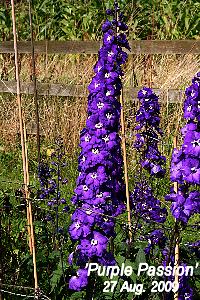 Among the other seedlings we had
several with pale pink flowers, two with deep purple flowers and
one with blue and mauve flowers. The only conclusion to be drawn
is that pollination by bees is very important so if you really
want white delphiniums you need to grow either F1 seed from a
cross between two plants that both have white flowers or from a
genuinely true-breeding line like the original Pacific Hybrids!
Among the other seedlings we had
several with pale pink flowers, two with deep purple flowers and
one with blue and mauve flowers. The only conclusion to be drawn
is that pollination by bees is very important so if you really
want white delphiniums you need to grow either F1 seed from a
cross between two plants that both have white flowers or from a
genuinely true-breeding line like the original Pacific Hybrids!
Among the other commercial F1 hybrids grown in 2009, the most uniform was the New Millenium "Purple Passion" strain. The plants have stiff slender stems with a dark colouration and relatively large deep purple flowers with good white eyes on blooms that were columnar in form. The colour generally lacked the exciting luminosity seen in 'Summerfield Oberon' but among the 50 odd plants grown, a few had tapered blooms and luminous deep purple flowers. Relatively few of these plants were badly affected by mildew, whereas the only plant of 'Pagan Purples' was utterly ruined as were most of the plants of the blue-flowered 'Royal Aspirations' strain. These New Zealand Hybrids appear to be no more resistant to attacks of mildew in the July-September period than any of our own delphiniums. It will be interesting to see the quality of their second year flowers and how well the plants have survived the present 2009/2010 winter with prolonged periods of hard frost and heavy snow falls.
A small postcript to the previous paragraph (added in February 2011) is that many of the plantsof 'Purple Passion' had grossly malformed flower stems and all were discarded. With even more severe frost during the past two months it is quite possible that many of our own cultivars will show growth abnormalities, although the plants were fully dormant at the time, whereas the Purpl;e Passion had started into growth when frosted.
| Return to Home Page | Return to Contents List |